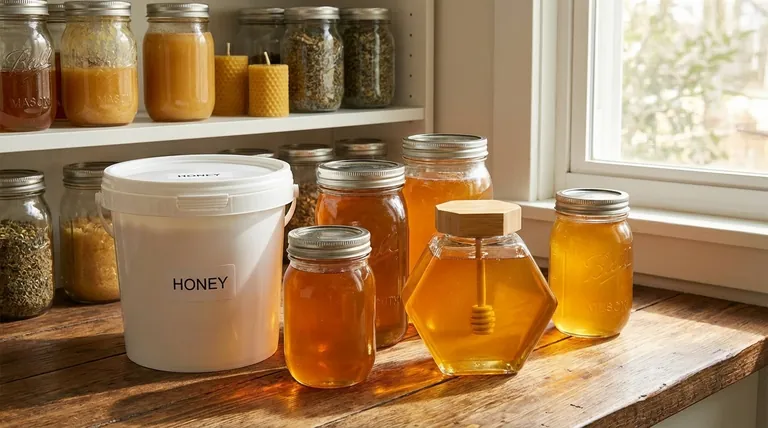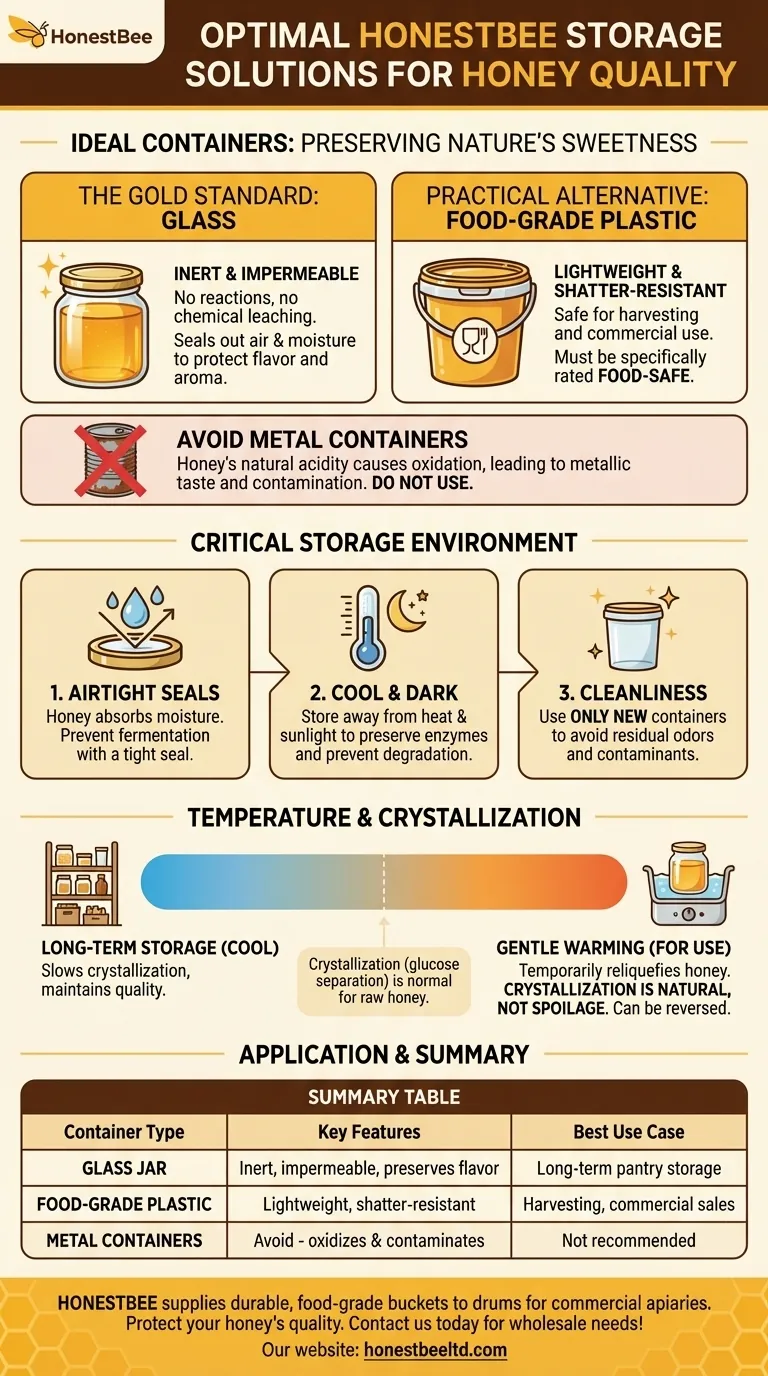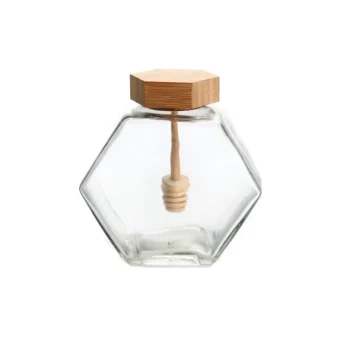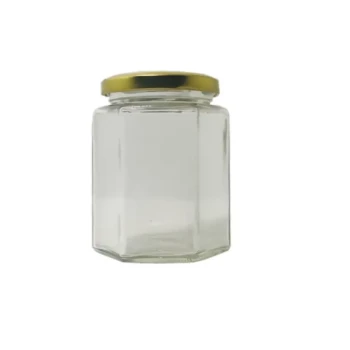For storing honey, the ideal container is a glass jar with a tight-fitting, airtight lid. Food-grade plastic containers are also a safe and practical alternative. The primary goal is to use a non-reactive material that can be sealed securely to protect the honey from air, moisture, and contamination, which are the main threats to its quality.
The choice of a honey container is about more than just holding a liquid; it's about preserving its unique chemical and physical properties. The best containers are made from inert materials like glass or food-grade plastic, which prevent chemical reactions and, when sealed, protect against moisture and air that degrade honey over time.

Why the Right Material is Crucial
The material your container is made from has a direct impact on the honey's flavor, color, and longevity. The wrong material can introduce unwanted chemicals or cause oxidation.
Glass: The Gold Standard
Glass is the preferred material for honey storage. It is inert, meaning it will not react with the honey or leach any chemicals into it.
It is also impermeable, preventing any air or moisture from passing through its walls. This protects the honey's delicate aroma and flavor profile.
Food-Grade Plastic: The Practical Alternative
While glass is ideal, food-grade plastic is a common and acceptable alternative, especially for harvesting and commercial sales.
Its main advantages are that it is lightweight and shatter-resistant. It is critical, however, to ensure the plastic is specifically rated as food-safe, as non-food-grade plastics can leach harmful chemicals.
Why Metal Containers Must Be Avoided
You should never store honey in most common metal containers. Honey is naturally acidic, and this acidity can cause the metal to oxidize.
This reaction can contaminate the honey, imparting a metallic taste and potentially introducing harmful compounds.
The Critical Role of the Storage Environment
Where and how you store the container is just as important as the container itself. Three factors are key: the seal, the temperature, and the container's history.
Airtight Seals are Non-Negotiable
Honey is hygroscopic, which means it readily absorbs moisture from the surrounding air. A tight, secure seal is essential to prevent this.
Excess moisture can increase the honey's water content, which can lead to fermentation and spoil the batch.
Cool and Dark for Longevity
Honey should be stored in a cool, dark place like a pantry, away from direct sunlight and heat sources like your stove.
Heat and light can degrade the sensitive enzymes and antioxidants in honey, diminishing its nutritional value and altering its flavor. Storing it in a cool location also helps slow down the natural process of crystallization.
The Cleanliness Factor
Always use new containers. Second-hand containers, even if they seem clean, can harbor residual odors or microscopic contaminants that will spoil your honey.
Understanding the Trade-offs: Temperature and Crystallization
Managing honey often involves a careful balance of temperature, as what's suitable for storage isn't always suitable for use.
Storing Cool vs. Gentle Warming
The "store in a cool place" rule is for long-term preservation. However, you may find your honey has crystallized and become solid.
In this case, a gentle warming is necessary to return it to a liquid state. Tools like honey bucket warmers provide consistent, low heat to reliquefy honey without damaging its natural properties. This is a temporary measure for use, not a long-term storage strategy.
Crystallization is Natural, Not a Sign of Spoilage
It is essential to understand that crystallization is a natural process for raw honey and is not a sign of spoilage. It simply means the glucose is separating from the water.
This process can be easily reversed by gently warming the container in a bowl of warm water or with a dedicated warmer.
How to Apply This to Your Goal
The best container depends on what you are trying to accomplish, from simple pantry storage to large-scale harvesting.
- If your primary focus is long-term pantry preservation: Choose glass jars with tight, airtight lids and store them in a cool, dark cabinet.
- If your primary focus is practicality during harvesting or for selling: Use new, food-grade plastic buckets or jars with secure, sealable tops for a lightweight and durable solution.
- If you are dealing with large, commercial quantities: Industry-standard 200-liter food-grade drums are the necessary choice for bulk storage and transport.
Ultimately, selecting a clean, airtight, and non-reactive container is the most important step you can take to protect the quality of your honey.
Summary Table:
| Container Type | Key Features | Best Use Case |
|---|---|---|
| Glass Jar | Inert, impermeable, preserves flavor | Long-term pantry storage |
| Food-Grade Plastic | Lightweight, shatter-resistant | Harvesting, commercial sales |
| Metal Containers | Avoid—can oxidize and contaminate honey | Not recommended |
Need the right containers for your honey operation? HONESTBEE supplies commercial apiaries and distributors with durable, food-grade storage solutions, from buckets to drums. Protect your honey's quality—contact us today to discuss your wholesale needs!
Visual Guide

Related Products
- Hexagonal Glass Honey Jar with Wooden Lid Integrated Dipper Elegant Functional Storage
- Classic Drum Shaped Glass Honey Jar with Airtight Lid
- Hexagonal Glass Honey Jars with Metal Lug Caps Elegant Versatile Packaging
- Classic Beehive Honey Bottle Jar with Squeeze Dispenser Lid
- Inverted Squeezable Honey Jar with No Drip Flip Top Cap for Easy Pouring
People Also Ask
- How long can you store honey in a 5 gallon bucket? Preserve Quality & Safety for Decades
- Can you store honey in a plastic bucket? Yes, with the right food-grade HDPE.
- What are the features of honey bottles? Design for Convenience & Long-Term Preservation
- What is the best container to store honey in? Preserve Purity & Flavor for Years
- What are the advantages of glass containers for honey packaging? Ensure Purity and Elevate Your Brand



















